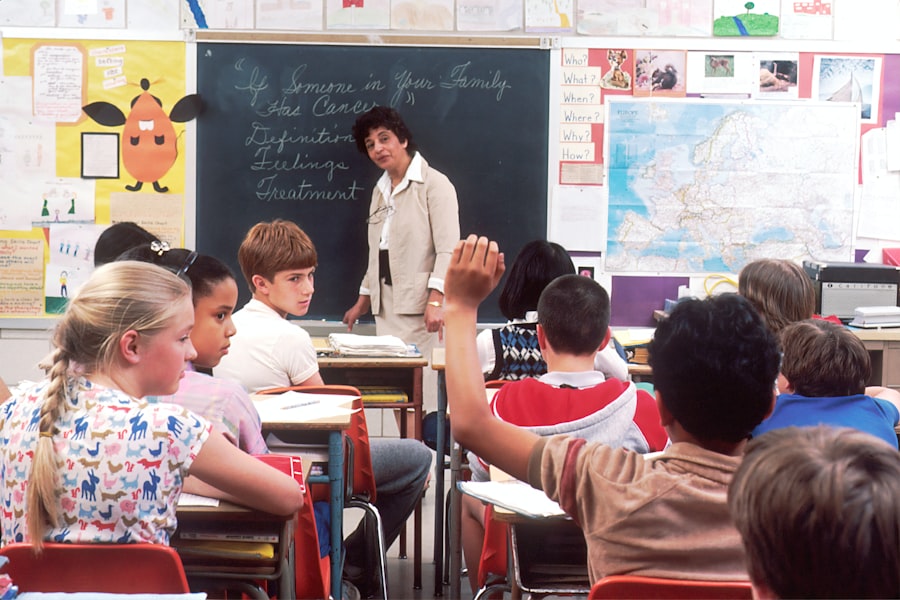Blended learning is an educational approach that combines traditional face-to-face classroom instruction with online learning experiences. This hybrid model allows educators to leverage the strengths of both in-person and digital teaching methods, creating a more flexible and personalized learning environment for students. In essence, blended learning integrates various instructional modalities, enabling learners to engage with content through multiple channels, such as videos, interactive simulations, and collaborative online platforms.
The goal is to enhance the educational experience by providing diverse opportunities for students to acquire knowledge and skills, catering to different learning styles and preferences. The concept of blended learning has evolved significantly over the years, particularly with the advent of advanced technology and the increasing accessibility of the internet. It is not merely a combination of online and offline learning; rather, it represents a strategic approach to education that emphasizes the importance of both modalities working in tandem.
By incorporating online resources into the curriculum, educators can extend learning beyond the confines of the classroom, allowing students to access materials at their own pace and revisit complex topics as needed. This flexibility fosters a more student-centered approach, where learners take an active role in their education, ultimately leading to improved engagement and retention of information.
Key Takeaways
- Blended learning combines traditional face-to-face instruction with online learning activities.
- Benefits of blended learning include increased flexibility, personalized learning, and improved student engagement.
- Types of blended learning models include rotation, flex, a la carte, and enriched virtual.
- Implementing blended learning in schools requires careful planning, teacher training, and access to technology.
- Challenges of blended learning include technology integration, student access to devices and internet, and teacher resistance.
- Blended learning in higher education offers opportunities for self-paced learning, flipped classrooms, and hybrid courses.
- Technology plays a crucial role in blended learning, providing access to online resources, collaboration tools, and learning management systems.
- Future trends in blended learning include adaptive learning technologies, virtual reality, and artificial intelligence integration.
Benefits of Blended Learning
One of the primary benefits of blended learning is its ability to cater to diverse learning styles and preferences. In a traditional classroom setting, teachers often face the challenge of addressing the varying needs of students simultaneously. However, blended learning allows for a more tailored approach, as students can engage with content in ways that resonate with them personally.
For instance, visual learners may benefit from video lectures and infographics, while auditory learners might prefer podcasts or discussions. This adaptability not only enhances comprehension but also empowers students to take ownership of their learning journey, fostering a sense of autonomy and motivation. Another significant advantage of blended learning is its potential to improve student outcomes.
Research has shown that when students are given the opportunity to learn through a combination of methods, they tend to perform better academically compared to those who rely solely on traditional instruction. The online component of blended learning often includes interactive elements such as quizzes, discussion boards, and collaborative projects, which can reinforce understanding and encourage critical thinking. Additionally, the flexibility inherent in blended learning allows students to revisit challenging concepts and practice skills at their own pace, leading to deeper mastery of the subject matter.
Types of Blended Learning Models

Blended learning encompasses a variety of models that can be tailored to meet the specific needs of educational institutions and their students. One popular model is the “flipped classroom,” where traditional lecture content is delivered online, allowing class time to be dedicated to interactive activities such as discussions, group work, or hands-on projects. This approach shifts the focus from passive listening to active engagement, enabling students to apply what they have learned in a collaborative environment.
The flipped classroom model has gained traction in recent years due to its effectiveness in promoting deeper understanding and critical thinking skills. Another widely recognized model is the “station rotation” approach, which involves students rotating between different learning stations that include both online and offline activities. In this model, students may spend part of their time working on digital assignments at a computer station while also participating in small group discussions or hands-on projects at other stations.
This structure not only keeps students engaged but also allows for differentiated instruction, as teachers can tailor activities to meet individual needs. By incorporating various modalities into the learning experience, the station rotation model fosters a dynamic classroom environment that encourages collaboration and creativity.
Implementing Blended Learning in Schools
| Metrics | 2019 | 2020 | 2021 |
|---|---|---|---|
| Number of schools implementing blended learning | 500 | 750 | 1000 |
| Percentage of students engaged in blended learning | 30% | 45% | 60% |
| Teacher training hours for blended learning | 1000 | 1500 | 2000 |
Successfully implementing blended learning in schools requires careful planning and consideration of various factors. First and foremost, educators must assess their current curriculum and identify areas where online resources can enhance traditional instruction. This may involve selecting appropriate digital tools and platforms that align with learning objectives while also considering the technological proficiency of both teachers and students.
Professional development for educators is crucial in this process, as teachers need to be equipped with the skills and knowledge necessary to effectively integrate technology into their teaching practices. Moreover, fostering a supportive school culture is essential for the successful adoption of blended learning. Administrators should encourage collaboration among teachers and provide opportunities for them to share best practices and resources.
Additionally, involving parents and guardians in the process can help create a community-wide understanding of blended learning’s benefits and expectations. By establishing clear communication channels and providing ongoing support, schools can create an environment where blended learning thrives, ultimately leading to improved student engagement and achievement.
Challenges of Blended Learning
Despite its numerous advantages, blended learning also presents several challenges that educators must navigate. One significant hurdle is ensuring equitable access to technology for all students. In many cases, disparities in access to devices or reliable internet connections can hinder some learners from fully participating in online components of their education.
Schools must address these inequities by providing necessary resources or alternative solutions for students who may lack access at home. Without addressing these barriers, the potential benefits of blended learning may not be realized for all students. Another challenge lies in the need for ongoing professional development for educators.
While many teachers are enthusiastic about incorporating technology into their classrooms, they may lack the training or confidence needed to effectively implement blended learning strategies. Schools must prioritize continuous professional development opportunities that focus on best practices for blended instruction, digital tool integration, and data-driven decision-making. By investing in teacher training and support, schools can ensure that educators are well-prepared to navigate the complexities of blended learning and provide high-quality instruction for their students.
Blended Learning in Higher Education

Flexibility and Community
By adopting hybrid course models, universities can offer students the flexibility of online lectures while still providing valuable face-to-face interaction with instructors and peers. This approach enables students to engage more deeply with course material, collaborate on projects in real-time, and foster a sense of community within the academic environment.
Access to Global Resources
Blended learning in higher education also facilitates greater access to diverse resources and expertise. Students can take advantage of online courses offered by institutions around the world, allowing them to explore subjects that may not be available at their home institution. This global perspective enriches the educational experience and encourages cross-cultural collaboration among students from different backgrounds.
Accommodating Diverse Student Needs
Furthermore, blended learning can help accommodate non-traditional students who may have work or family commitments that make attending classes on campus challenging. By offering flexible scheduling options and varied instructional formats, higher education institutions can better serve a diverse student population.
Technology and Blended Learning
Technology plays a pivotal role in the success of blended learning initiatives. The rapid advancement of digital tools has transformed how educators deliver content and engage with students. Learning management systems (LMS) have become essential platforms for organizing course materials, tracking student progress, and facilitating communication between instructors and learners.
These systems allow educators to create interactive online modules that complement traditional instruction while providing valuable data on student performance that can inform instructional decisions. Furthermore, emerging technologies such as artificial intelligence (AI) and virtual reality (VR) are beginning to shape the future of blended learning. AI-driven platforms can personalize learning experiences by adapting content based on individual student needs and preferences, ensuring that each learner receives targeted support.
Meanwhile, VR technology offers immersive experiences that can enhance understanding of complex concepts by allowing students to explore virtual environments or simulations related to their studies. As technology continues to evolve, it will undoubtedly play an increasingly integral role in shaping effective blended learning experiences.
Future Trends in Blended Learning
Looking ahead, several trends are likely to influence the future landscape of blended learning. One notable trend is the growing emphasis on personalized learning pathways that cater to individual student needs and interests. As educational institutions increasingly recognize the importance of tailoring instruction to meet diverse learner profiles, blended learning models will likely evolve to incorporate more adaptive technologies that facilitate personalized experiences.
This shift will empower students to take greater control over their educational journeys while promoting engagement and motivation. Additionally, there is a rising focus on social-emotional learning (SEL) within blended environments. Educators are beginning to understand that fostering emotional intelligence and interpersonal skills is just as crucial as academic achievement.
Blended learning provides unique opportunities for SEL integration through collaborative online projects and peer interactions during face-to-face sessions. As schools continue to prioritize holistic education approaches that address both cognitive and emotional development, blended learning will play an essential role in creating supportive environments where all students can thrive academically and personally. In conclusion, blended learning represents a transformative approach to education that combines traditional teaching methods with innovative online resources.
Its ability to cater to diverse learning styles while improving student outcomes makes it an attractive option for educators across various levels of education. However, successful implementation requires careful planning, ongoing professional development for teachers, and a commitment to addressing challenges such as equitable access to technology. As we look toward the future, it is clear that blended learning will continue to evolve alongside advancements in technology and pedagogical practices, ultimately shaping the way we teach and learn in an increasingly interconnected world.
For those interested in exploring more about blended learning strategies and their effectiveness, I recommend reading an insightful article available at ClompCorp. The article delves into various methodologies of blended learning, comparing traditional educational methods with modern, technology-integrated approaches. It provides a comprehensive analysis that can be beneficial for educators looking to implement or improve their blended learning techniques. You can read the full article by following this link: Exploring Blended Learning Strategies.
FAQs
What is blended learning?
Blended learning is an educational approach that combines traditional face-to-face classroom instruction with online learning activities. It integrates technology and digital resources to enhance the learning experience.
What are the benefits of blended learning?
Blended learning offers flexibility for students to learn at their own pace, access a variety of resources, and receive personalized instruction. It also promotes collaboration, critical thinking, and problem-solving skills.
How does blended learning work?
Blended learning typically involves a mix of in-person instruction, online learning modules, virtual discussions, and multimedia resources. It can be implemented in various ways, such as flipped classrooms, rotation models, and flex models.
What are some examples of blended learning activities?
Examples of blended learning activities include online discussions, interactive simulations, virtual labs, multimedia presentations, and self-paced modules. These activities can be accessed through learning management systems or other online platforms.
What are the challenges of implementing blended learning?
Challenges of implementing blended learning include ensuring access to technology and internet connectivity, training educators to effectively integrate technology into instruction, and maintaining student engagement in both online and in-person learning environments.



